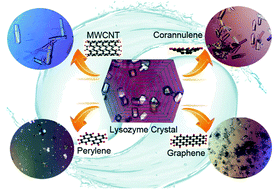Exploring the effects and mechanisms of carbon nanomaterial diversity on the morphology of lysozyme crystals†
Abstract
Carbon nanomaterials (CNMs) provide various surface charges, structural characteristics and energy features for nano-engineering applications, but the effects of CNMs on crystallization have remained unclear. In this study, we used non-functionalized multi-walled carbon nanotubes (MWCNT), graphene, perylene and corannulene to induce lysozyme heterogeneous nucleation and investigate the potential mechanisms. We found that adding three-dimensional (3D) CNMs, corannulene and MWCNT increased the {001} face growth and led to more pronounced X-ray diffraction peaks. The two-dimensional (2D) CNMs graphene and perylene decreased both {110} and {001} face growth and led to lower X-ray diffraction peaks. According to two-dimensional nucleation models, the potential mechanisms of crystallization with CNM addition were detected. The result showed that adding CNMs altered the X–Y : W–Z ratio of bonding energies, which could be a potential mechanism for changing the morphological structure of lysozyme crystals. In general, a shift in the final size distribution and morphology was observed, and more pronounced X-ray diffraction peaks were achieved in lysozyme crystals with the addition of 3D CNMs.



 Please wait while we load your content...
Please wait while we load your content...